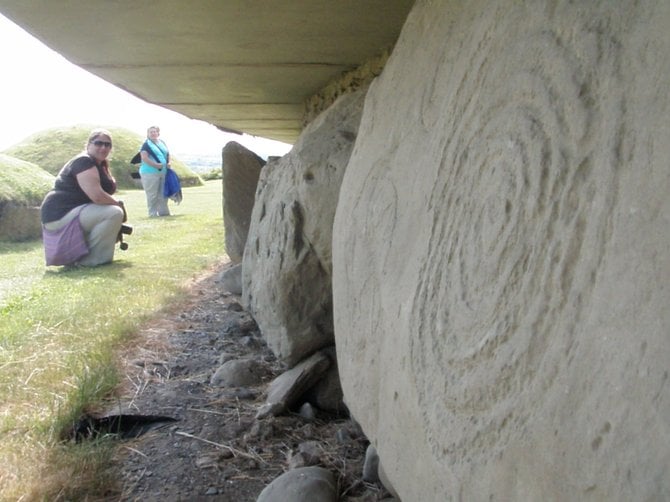 Facebook
Facebook
 X
X
 Instagram
Instagram
 TikTok
TikTok
 Youtube
Youtube

"All of these mounds have a hole straight down into them. When you go up top, you'll see," says the guide at Knowth.
County Meath, Ireland, is one of the earliest known developments – older than Stonehenge, older than the Pyramids. The giant grassy mound of Knowth looms ahead of me, the land around it peppered with smaller mounds. Small boulders called "kerbstones" ring the mound, most with designs carved into them. Originally, these helped hold the mound up. Today, however, this task is performed by a concrete ledge built just above the stones.
"So people can see the stones," we're told.
The intrusion of the cement bursts the authenticity bubble somewhat, but the entire thing had been excavated anyway. And the stones are a marvel to behold. Esoteric symbols, wavy lines and concentric circles are carved into the stone, giving a glimpse into thoughts of some of the earliest civilizations of mankind.
There is debate as to their meaning. Are they symbols, writing of some kind? Celestial diagrams? Simply art, perhaps? The second seems most likely, as Knowth (as well as the two other nearby passage tombs of Newgrange and Dowth) had east and west passages perfectly aligned to the cycles of the sun.
While cremated remains were found in the center of the mound, it seems more set to worshiping the heavens than merely serving as a tomb. The passages no longer line up properly – but that’s a testament to the historical lifespan of the mound. These mounds have been used almost continuously by different societies since the Celts built them some 5,000 years ago.
Recognized for defensive benefits in what was historically a contentious zone along the east coast of Ireland, Knowth had forts constructed atop it &mdash even a moat carved into its outer edge, which did the most damage to the alignment of the passages. On a loop in the River Boyne, the mound saw use up through the Christian era, with a few houses constructed on it during the 1700s before it was left to nature.
So everything we see is a reconstruction, an artificial return to mankind's earliest days. Never mind the concrete. I'm thinking this as I peer down the hole in the top of one of the satellite mounds, right before the guide yells at me for being on top of it. She'd said, "When you go up top," right? Besides, after thousands of years, what's one more set of feet?


"All of these mounds have a hole straight down into them. When you go up top, you'll see," says the guide at Knowth.
County Meath, Ireland, is one of the earliest known developments – older than Stonehenge, older than the Pyramids. The giant grassy mound of Knowth looms ahead of me, the land around it peppered with smaller mounds. Small boulders called "kerbstones" ring the mound, most with designs carved into them. Originally, these helped hold the mound up. Today, however, this task is performed by a concrete ledge built just above the stones.
"So people can see the stones," we're told.
The intrusion of the cement bursts the authenticity bubble somewhat, but the entire thing had been excavated anyway. And the stones are a marvel to behold. Esoteric symbols, wavy lines and concentric circles are carved into the stone, giving a glimpse into thoughts of some of the earliest civilizations of mankind.
There is debate as to their meaning. Are they symbols, writing of some kind? Celestial diagrams? Simply art, perhaps? The second seems most likely, as Knowth (as well as the two other nearby passage tombs of Newgrange and Dowth) had east and west passages perfectly aligned to the cycles of the sun.
While cremated remains were found in the center of the mound, it seems more set to worshiping the heavens than merely serving as a tomb. The passages no longer line up properly – but that’s a testament to the historical lifespan of the mound. These mounds have been used almost continuously by different societies since the Celts built them some 5,000 years ago.
Recognized for defensive benefits in what was historically a contentious zone along the east coast of Ireland, Knowth had forts constructed atop it &mdash even a moat carved into its outer edge, which did the most damage to the alignment of the passages. On a loop in the River Boyne, the mound saw use up through the Christian era, with a few houses constructed on it during the 1700s before it was left to nature.
So everything we see is a reconstruction, an artificial return to mankind's earliest days. Never mind the concrete. I'm thinking this as I peer down the hole in the top of one of the satellite mounds, right before the guide yells at me for being on top of it. She'd said, "When you go up top," right? Besides, after thousands of years, what's one more set of feet?
Comments